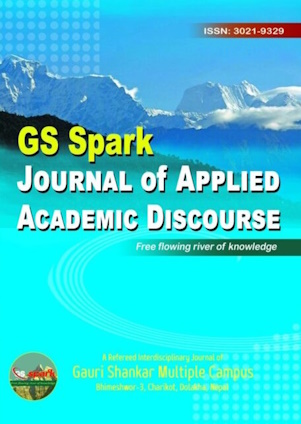The Remittance Dilemma in Nepal: Dependency, Economic Distortion, and the Challenges.
Research Article
GS Spark: Journal of Applied Academic Discourse, Volume 3, Issue 1, June 2025, -
Publication date: Sep 04, 2025
Views: 136 | Downloads: 0
How to cite this article
APA
In-text citation: (Bhandari, 2025)
Reference: Bhandari, R. (2025). The Remittance Dilemma in Nepal: Dependency, Economic Distortion, and the Challenges.. GS Spark: Journal of Applied Academic Discourse, 3(1), -.
Reference: Bhandari, R. (2025). The Remittance Dilemma in Nepal: Dependency, Economic Distortion, and the Challenges.. GS Spark: Journal of Applied Academic Discourse, 3(1), -.
Vancouver
In-text citation: (1), (2), (3), etc.
Reference: Bhandari R. The Remittance Dilemma in Nepal: Dependency, Economic Distortion, and the Challenges.. GS Spark: Journal of Applied Academic Discourse. 2025;3(1):.
Reference: Bhandari R. The Remittance Dilemma in Nepal: Dependency, Economic Distortion, and the Challenges.. GS Spark: Journal of Applied Academic Discourse. 2025;3(1):.
AMA
In-text citation: (1), (2), (3), etc.
Reference: Bhandari R. The Remittance Dilemma in Nepal: Dependency, Economic Distortion, and the Challenges.. GS Spark: Journal of Applied Academic Discourse. 2025;3(1), -.
Reference: Bhandari R. The Remittance Dilemma in Nepal: Dependency, Economic Distortion, and the Challenges.. GS Spark: Journal of Applied Academic Discourse. 2025;3(1), -.
Chicago
In-text citation: (Bhandari, 2025)
Reference: Bhandari, Ramesh. "The Remittance Dilemma in Nepal: Dependency, Economic Distortion, and the Challenges.". GS Spark: Journal of Applied Academic Discourse 2025 3 no. 1 (2025): -.
Reference: Bhandari, Ramesh. "The Remittance Dilemma in Nepal: Dependency, Economic Distortion, and the Challenges.". GS Spark: Journal of Applied Academic Discourse 2025 3 no. 1 (2025): -.
Harvard
In-text citation: (Bhandari, 2025)
Reference: Bhandari, R. (2025). The Remittance Dilemma in Nepal: Dependency, Economic Distortion, and the Challenges.. GS Spark: Journal of Applied Academic Discourse, 3(1), pp. -.
Reference: Bhandari, R. (2025). The Remittance Dilemma in Nepal: Dependency, Economic Distortion, and the Challenges.. GS Spark: Journal of Applied Academic Discourse, 3(1), pp. -.
MLA
In-text citation: (Bhandari, 2025)
Reference: Bhandari, Ramesh "The Remittance Dilemma in Nepal: Dependency, Economic Distortion, and the Challenges.". GS Spark: Journal of Applied Academic Discourse, vol. 3, no. 1, 2025, pp. -.
Reference: Bhandari, Ramesh "The Remittance Dilemma in Nepal: Dependency, Economic Distortion, and the Challenges.". GS Spark: Journal of Applied Academic Discourse, vol. 3, no. 1, 2025, pp. -.
ABSTRACT
Remittances have become a critical pillar of Nepal’s economy, constituting over 26% of GDP in 2023. While they provide significant short-term benefits such as poverty reduction and foreign exchange stability, concerns about long-term economic dependency, reduced labor force participation, and stagnating industrial growth have intensified. Despite high remittance inflows, Nepal continues to face structural economic challenges, including trade deficits, underinvestment in productive sectors, and a shrinking domestic workforce. This study is essential to understanding how remittance dependency may hinder sustainable development and industrial transformation, particularly in regions heavily reliant on outmigration. Remittance inflows, while stabilizing the economy, have inadvertently become a crutch that deters industrial development and deepens structural vulnerabilities, especially through reduced capital formation, "Dutch Disease" effects, and social disruption due to youth migration. Using a qualitative, literature-based approach, the study found that over 78.9% of remittances in Nepal are spent on daily consumption, while only 2.4% are allocated to capital formation. The appreciation of the Nepalese rupee has weakened the competitiveness of tradable sectors, discouraging industrial output. The paper concludes that without strategic policy reforms, such as financial literacy, diaspora engagement, and investment redirection, Nepal’s remittance-driven economy risks long-term stagnation.
REFERENCES
---
LICENSE
This work is licensed under a Creative Commons Attribution-NonCommercial 4.0 International License.

